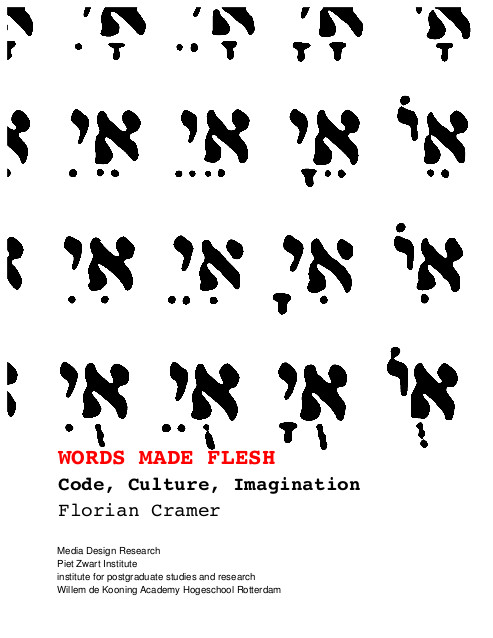Terry Harpold: Ex-foliations: Reading Machines and the Upgrade Path (2008)
Filed under book | Tags: · fiction, hypertext, literature, reading, screen, technology, text, theory

“Every reading is, strictly speaking, unrepeatable; something in it, of it, will vary. Recollections of reading accumulate in relation to this iterable specificity; each takes its predecessors as its foundation, each inflects them with its backward-looking futurity.” In Ex-foliations, Terry Harpold investigates paradoxes of reading’s backward glances in the theory and literature of the digital field.
In original analyses of Vannevar Bush’s Memex and Ted Nelson’s Xanadu, and in innovative readings of early hypertext fictions by Michael Joyce and Shelley Jackson, Harpold asserts that we should return to these landmarks of new media scholarship with newly focused attention on questions of media obsolescence, changing user interface designs, and the mutability of reading.
In these reading machines, Harpold proposes, we may detect traits of an unreadable surface—the real limit of the machines’ operations and of the reader’s memories—on which text and image are projected in the late age of print.
Publisher U of Minnesota Press, 2008
ISBN 0816651027, 9780816651023
368 pages
PDF (updated on 2013-1-23)
Comment (0)Friedrich A. Kittler: Gramophone, Film, Typewriter (1986–) [DE, EN]
Filed under book | Tags: · film, history of technology, literary theory, literature, media, media archeology, media theory, poetry, psychoanalysis, sound, sound recording, technology, typewriter, writing

“Toward the end of the nineteenth century, the hegemony of the printed word was shattered by the arrival of new media technologies that offered novel ways of communicating and storing data. Previously, writing had operated by way of symbolic mediation—all data had to pass through the needle’s eye of the written signifier—but phonography, photography, and cinematography stored physical effects of the real in the shape of sound waves and light. The entire question of referentiality had to be recast in light of these new media technologies; in addition, the use of the typewriter changed the perception of writing from that of a unique expression of a literate individual to that of a sequence of naked material signifiers.
Part technological history of the emergent new media in the late nineteenth century, part theoretical discussion of the responses to these media—including texts by Rilke, Kafka, and Heidegger, as well as elaborations by Edison, Bell, Turing, and other innovators—Gramophone, Film, Typewriter analyzes this momentous shift using insights from the work of Foucault, Lacan, and McLuhan. Fusing discourse analysis, structuralist psychoanalysis, and media theory, the author adds a vital historical dimension to the current debates over the relationship between electronic literacy and poststructuralism, and the extent to which we are constituted by our technologies. The book ties the establishment of new discursive practices to the introduction of new media technologies, and it shows how both determine the ways in which psychoanalysis conceives of the psychic apparatus in terms of information machines.
Gramophone, Film, Typewriter is, among other things, a continuation as well as a detailed elaboration of the second part of the author’s Discourse Networks, 1800/1900 (Stanford, 1990). As such, it bridges the gap between Kittler’s discourse analysis of the 1980’s and his increasingly computer-oriented work of the 1990’s.”
Publisher Brinkmann & Bose, Berlin, 1986
ISBN 3922660177
427 pages
English edition
Translated, with an Introduction by Geoffrey Winthrop-Young and Michael Wutz
Publisher Stanford University Press, 1999
ISBN 0804732337, 9780804732338
315 pages
Reviews: Bruce Clarke (Electronic Book Review, 1999), Alex Magoun (Technology and Culture, 2001).
Grammophon Film Typewriter (German, 1986, 7 MB, added on 2014-6-30, updated on 2019-5-2)
Gramophone, Film, Typewriter (English, trans. Geoffrey Winthrop-Young and Michael Wutz, 1999, updated on 2012-10-13)
Florian Cramer: Words Made Flesh: Code, Culture, Imagination (2005)
Filed under book | Tags: · art, art history, code, code poetry, computation, experimental literature, kabbalah, language, literature, philosophy, poetry, religion, software, software art, technology

“Executable code existed centuries before the invention of the computer in magic, Kabbalah, musical composition and experimental poetry. These practices are often neglected as a historical pretext of contemporary software culture and electronic arts. Above all, they link computations to a vast speculative imagination that encompasses art, language, technology, philosophy and religion. These speculations in turn inscribe themselves into the technology. Since even the most simple formalism requires symbols with which it can be expressed, and symbols have cultural connotations, any code is loaded with meaning. This booklet writes a small cultural history of imaginative computation, reconstructing both the obsessive persistence and contradictory mutations of the phantasm that symbols turn physical, and words are made flesh.”
Editor: Matthew Fuller, additional corrections: T. Peal
Published within Media Design Research programme, Piet Zwart Institute, Willem de Kooning Academy Hogeschool, Rotterdam
GNU General Public License 2; GNU Free Documentation License 1.2; Creative Commons Attribution-ShareAlike License 2.0
141 pages
Review: Tomáš Javůrek (Joinme, 2018, CZ).
PDF (updated on 2012-10-11)
HTML (added on 2013-7-1)
Sequel: Exe.cut(up)able statements: Poetische Kalküle und Phantasmen des selbstausführenden Texts (2011, in German).
Comment (0)
